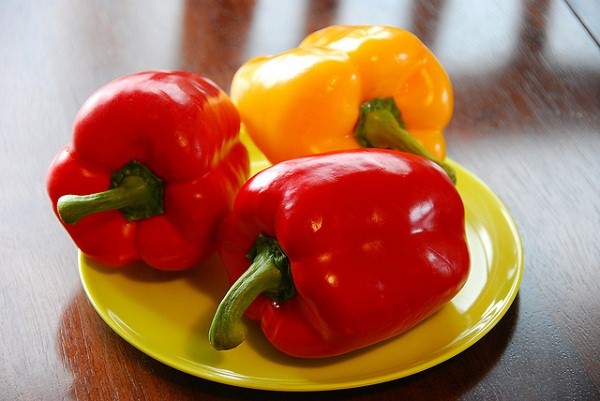 Sweet pepper is a must in all gardens! Residents of the cold regions of different countries have long been skilled in growing this delicious southern vegetable. And the works of breeders have deduced an incredible number of varieties and hybrids of sweet pepper that can satisfy the demand of even the most selective gardeners.
Sweet pepper is a must in all gardens! Residents of the cold regions of different countries have long been skilled in growing this delicious southern vegetable. And the works of breeders have deduced an incredible number of varieties and hybrids of sweet pepper that can satisfy the demand of even the most selective gardeners.
Content
Description and characteristics of pepper seeds
On the shelves of specialized stores there are hybrid and varietal seeds of peppers. Understanding the difference between these terms is very important when selecting seed.
- Varietal peppers are the result of selecting the best plant specimens. Breeders try to increase its fertility, while taking into account the weather conditions of cultivation. The seeds of varietal peppers can be harvested on their own, the offspring that they give will retain the signs of the original plant.
- Hybrid pepper (F1) is the result of crossbreeding between different varieties. The resulting plants usually have increased immunity to various negative factors, they give a higher yield of fruits, with excellent taste and marketability. They are more demanding to follow the rules of cultivation. Seeds collected from such plants will not transfer their properties to hereditary plants.
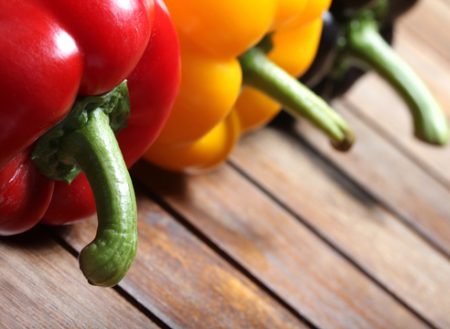
Gardeners who grow pepper for more than one year are advised to choose seeds with different ripening dates. At the same time, they need to be planted so that they do not become dusty. The distance between the varieties should be at least 2 m. Hot pepper should be planted as far as possible from the sweet. The same technique will help to get the original variety with independent seed harvesting.
Planting peppers with different ripening periods will allow you to enjoy delicious, fresh vegetables throughout the summer. More about the dates:
- early - it is better to plant such peppers in areas with a short summer, 80-110 days pass from sowing to picking ripe fruits;
- medium - suitable for growing in any conditions, they ripen 120-130 days after sowing;
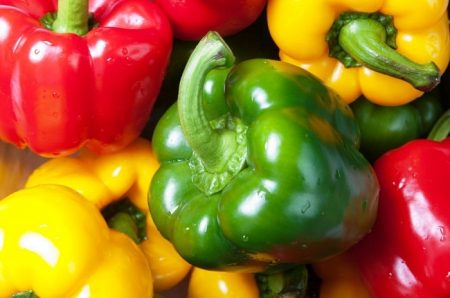
- later - such peppers are recommended for cities with a warm and long summer-autumn period, and they are also planted in various greenhouses. They need about 140 days to mature.
As for the conditions for cultivating a culture, let us recall its capricious disposition. In most of our country, in conditions of unprotected soil, pepper is difficult to grow. As already mentioned, hybrids show great resistance to atypical weather conditions. Another important moment when choosing seeds is the height of the plant, the higher the peppers, the more attention they need to pay.
And finally, I want to note the ability of fruits to store, this factor also needs to be considered when buying seed material, especially if the vegetable is grown for sale. More information can be found on the packaging. There are also options for sowing dates and recommendations for cultivating a variety or hybrid.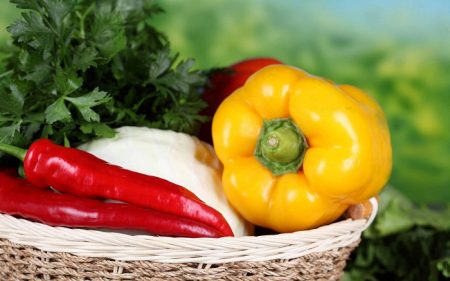
Seed Selection Rules
An important, and often decisive criterion for choosing pepper seeds is the characteristic of the fruit. This is especially important if a variety or hybrid is grown for a specific purpose. For example, hot peppers are most often purchased as a seasoning for spins and homemade dishes. For stuffing, choose varieties with smooth fruits.
The shape of sweet pepper is diverse - cone, cube, oval, ball. Fruits can be elongated or compressed, and very intricate shapes are also found. Peppers may be bumpy, ribbed, or completely smooth.Also with size, very large and very small fruits come across.
The main color options for pepper fruits are colors such as yellow, red and green. Now a huge number of varieties and hybrids are known that combine several colors and shades in color.
Atlantic
A large-fruited, early ripe (up to 80 days) hybrid of Dutch origin, which is extremely rarely ill and is not afraid of lowering the temperature. The bush is tall, medium-branched. Productivity is about 11 kg / m². It is grown under any conditions in all regions, it is resistant to the potato virus and tobacco mosaic.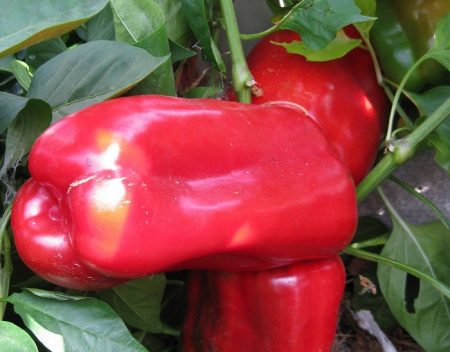
Peppers are thick-walled, in the form of a prism weigh from 120 to 250 grams. The color of the fruit in full ripeness is saturated red. The taste is rated as very good, no bitterness, there is a bright, fresh pepper aroma. The pulp is dense, of a pleasant consistency, the skin is thin and very tender.
Fakir
The variety, ripening in the early period (90-110 days), it can be grown in open and protected ground. The bush is slightly higher than half a meter, standard, medium-branched and medium-leafed. Disease resistance is excellent. Peppers are smooth, conical (elongated), uniform, red, thick-walled weighing 50-200 grams. The taste is sweet, Fakir is very prolific.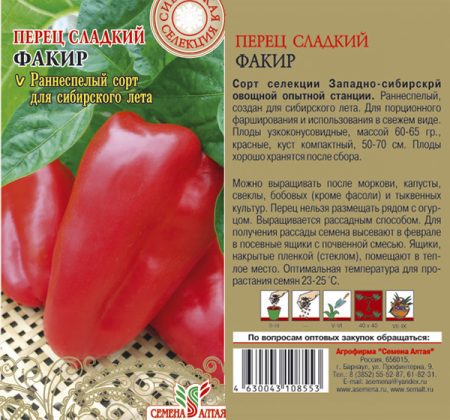
Prince Silver
Medium early (100–120 days), a highly productive sweet pepper variety for cultivation in unprotected soil in all regions. Resistance to negative factors affecting the culture is excellent. The bush is about 75 cm tall, medium thick. Peppers are smooth or slightly ribbed, cone-shaped, bright red. The taste is very good, sweet, intense. The weight of the fruit is from 100 to 200 grams, the wall thickness is about 7 mm.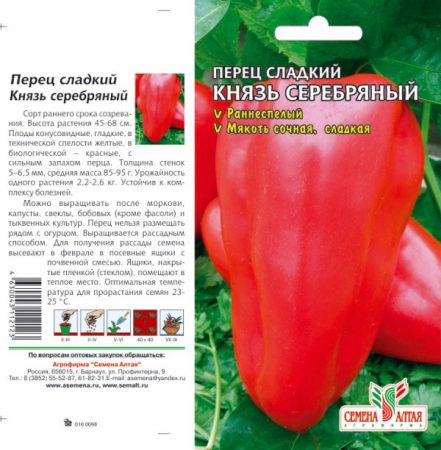
Hercules
An early ripe (100–110 days) variety of Russian selection, it can be grown in all regions in greenhouses and in open ground. Resistance to unfavorable conditions for the culture is good, growing problems are extremely rare. Fusarium variety is not afraid. The bush is not higher than 60 cm semi-spreading, very neat, leaves are slightly wrinkled.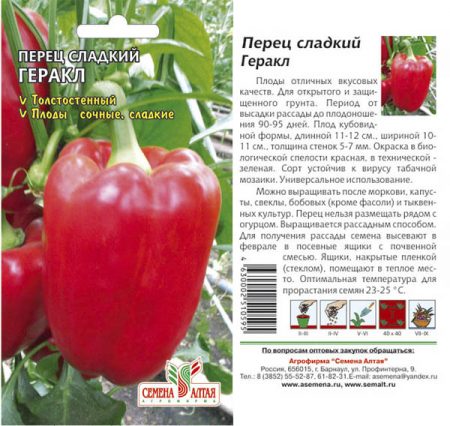
The peppers are thick-walled, red, smooth, cuboid up to 12 cm in length, fruit diameter about 11 cm, and weight 150–220 grams. The pulp is pleasant, sweet, without bitterness, the aroma is very saturated. The maximum yield from one bush is about 3 kg.
Arsenal
A variety of medium-term ripening (125–130 days), intended for cultivation under film shelters and in open ground. Arsenal is not afraid of most common diseases and develops well even in cool regions. The bush is up to 80 cm tall, slightly branched, semi-spreading.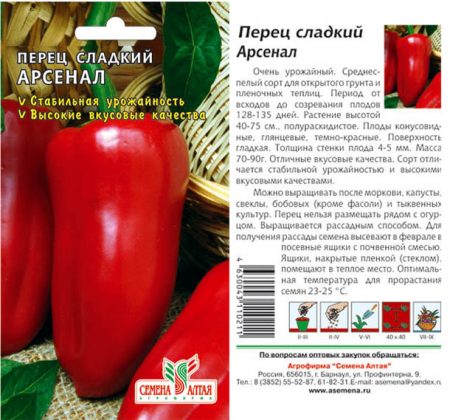
Peppers are conical, smooth, red from 120 to 150 grams. The walls are not thicker than 6 mm, the pulp is dense, sweet, there is no bitterness, the aroma is pleasant, unobtrusive. With proper care, one bush can produce up to 2 kg of crop.
Cow ear
Another very good variety with a medium ripening period (120–125 days). The plant is tall, up to 90 cm, medium-branched. The cow’s ear has good immunity to all negative factors. Fruits have keeping quality. Red peppers, elongated-conical in weight from 150 to 220 grams. The walls are about 6 mm, the pulp is very tasty, juicy and aromatic. Harvest from 1 m² about 3 kg.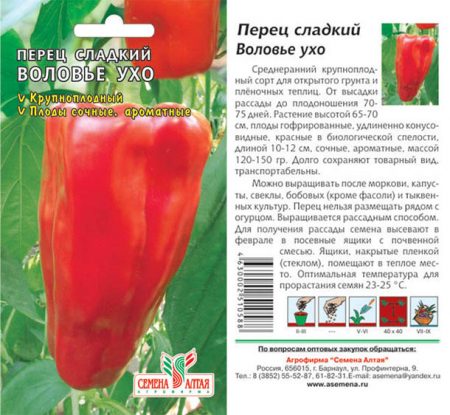
Gift of Moldova
A very old Moldavian variety; it was introduced into Russia as far back as 1973. Pepper of average ripening period (115–130 days), resistant to many diseases, can be grown in open and closed ground. Immunity to adverse weather conditions and diseases at a high level, this is especially noticeable when observing the main rules of agricultural technology.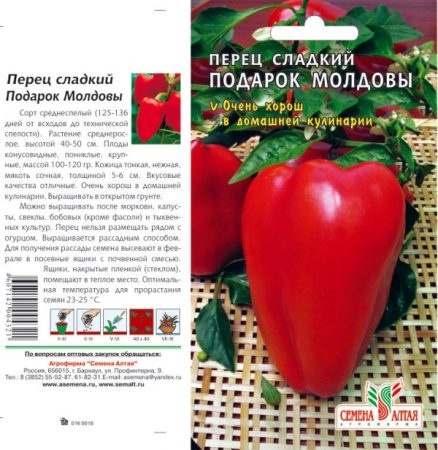
The bush is not higher than half a meter, standard. The fruits are conical in shape, the wall thickness is about 8 mm. The taste and marketability of red peppers are excellent. The variety is very popular in our country, it is easy to grow, and it also gives not small yields - up to 5 kg / m².
Poltava
A common, productive variety with a medium ripening period (100–120 days), it is cold-resistant, the fruits are still, they easily tolerate transportation. Peppers are actively formed throughout the growing season. Immunity to all negative factors is good.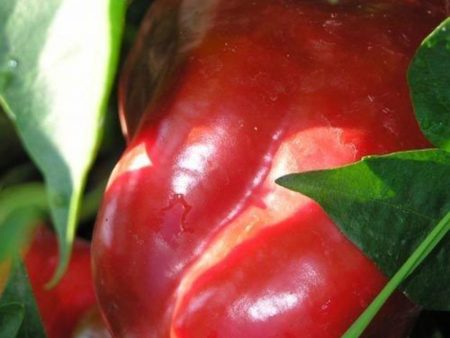
The plant is up to 70 cm tall, medium-sized, compact. Peppers are conical, slightly ribbed, red weighing up to 100 grams. The wall thickness is about 7 mm, the skin is dense, the flesh is juicy.
Lumina
The name of this variety is not familiar to everyone, however, everyone knows its taste. This is the same pepper, which was one of the first to appear in the spring on market and grocery stores. The variety is early ripe (100-110 days), fruitful, resistant to diseases, pests and is not particularly afraid of surprises from the weather. Fruits have keeping quality, they are transportable.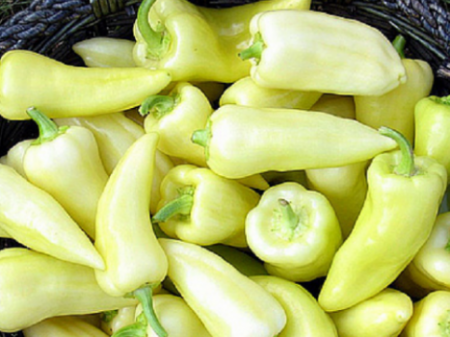
The bush is medium-sized, semi-spreading. Cone-shaped peppers, from golden yellow to red. The weight of the fruit is 100-120 grams, the walls are about 5 mm. Some gardeners describe the taste as neutral, the flesh is juicy and tender, moderately sweet, and there is no bitterness.
Orange miracle
Dutch variety of early ripening (95–110 days), recommended for cultivation in open and closed ground. A plant up to a meter tall, branched, requires support. Immunity to negative weather factors and diseases is good. The fruits retain their presentation for a long time, suitable for long-term storage and transportation over long distances.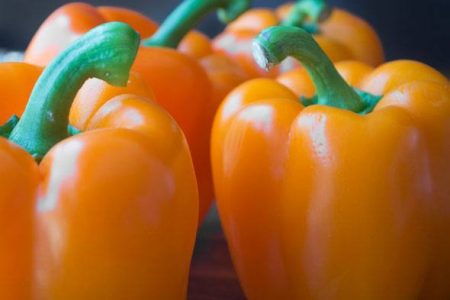
Peppers in the form of a cube, smooth, thick-walled orange weighing from 200 to 300 grams. The taste is very good, saturated pepper, sweet, juicy pulp. On one bush, up to 12 fruits are tied, with one m² you can collect up to 14 kg of the crop.
California Miracle
The fruits of the variety can be colored red, yellow, or orange. The plant is compact, not more than half a meter. Ripening period is average (120-130 days). Pepper California miracle is unpretentious to growing conditions, it is not afraid of the mosaic virus, it has the characteristics of hybrid peppers, although it is varietal. The fruits are smooth, fleshy and juicy in the shape of a cuboid. The taste and marketability are excellent, the weight of peppers ranges from 80 to 200 grams. Productivity up to 10 kg / m².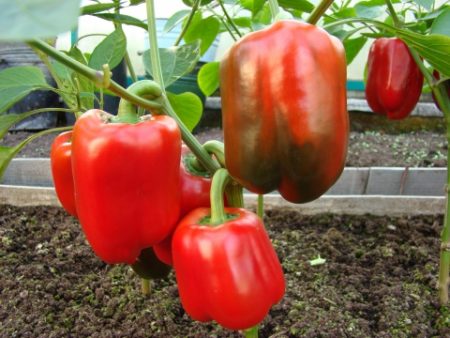
Ivanhoe
One of the best early ripe varieties of red pepper (100-125 days). It has excellent immunity to viruses and fungi, is not afraid of temperature changes and is unpretentious to growing conditions. The bush is compact, medium-sized, slightly branched, semi-ram. Peppers are very tasty, thick-walled, conical, red, weighing from 100 to 160 grams. Average yield 5 kg / 1 m²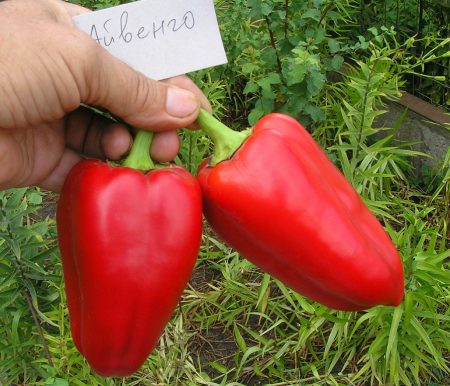
Claudio
Dutch hybrid early ripening. It develops well in the middle lane, it can be grown in open and closed ground. Claudio tolerates low temperatures and hot periods. Disease immunity is excellent.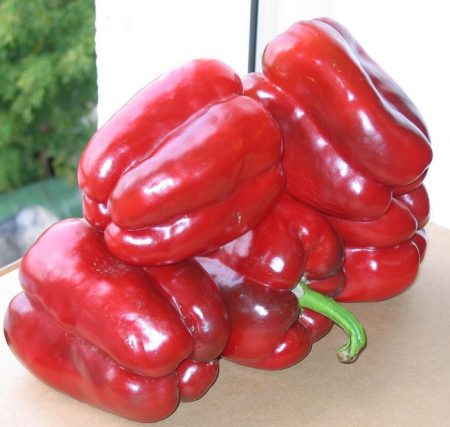
Bushes are straight, medium-sized, massive, form up to 12 fruits. Prismatic peppers, slightly elongated, red, weighing from 200 to 250 grams. The walls are slightly thicker than 1 cm, the pulp is juicy, sweet, incredibly tasty. The harvested crop is well stored, up to 4 kg is removed from 1 m².
Viking
Early ripe, high-yielding, very common variety for growing under film shelter and in the open ground. The bush is semi-spreading, medium-sized, at the same time about 4 fruits are tied on the plant. Resistance to the most common diseases is high, especially to the tobacco mosaic virus.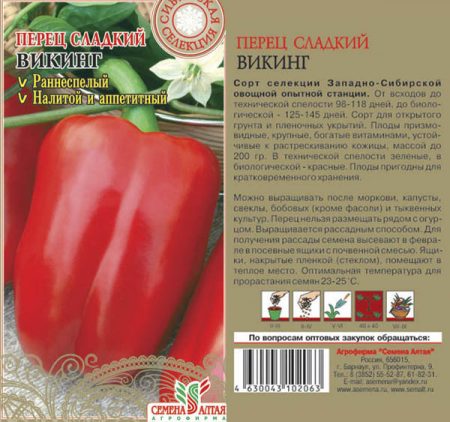
Prismatic fruits, red up to 200 grams. Walls about 7 mm, juicy flesh, sweet without bitterness. The skin does not crack, which means that the peppers are well stored, the variety is often grown for sale.
Marinkin tongue
Another very attractive mid-season (120-130 days) sweet pepper variety comes from Ukraine. It is very resistant to adverse weather conditions and is rarely affected by viruses or fungi - a find for growing in unprotected soil. The bush is medium-sized, up to 15 fruits are tied on it.The ripening period is average.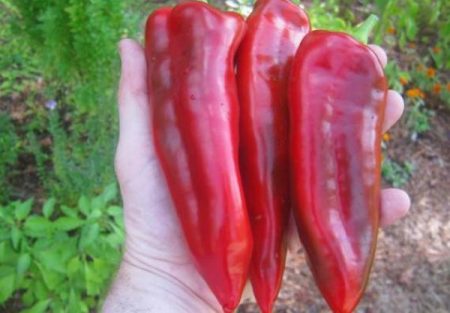
The variety received its name for a reason, red peppers in shape resemble a language. The wall thickness is up to 12 mm, the pulp is juicy, dense, sweet and aromatic. The average weight of the fruit is 250 grams. From 1 m² you can collect about 5 kg of crop.
High yield recommendations
Despite the characteristics of the described varieties, and they all differ in productivity, a good result can be obtained only if the rules of agricultural technology are observed:
- First of all, you must observe the sowing dates and do not forget about the preparation of seeds - rejection, disinfection, nutrition and germination;
- proper watering and feeding seedlings, highlighting and providing ideal conditions at all stages of growth have a big impact on future crops;
- the forerunners of peppers should not be eggplant, potatoes and tomatoes. The culture can be planted after zucchini, cucumbers, pumpkins and carrots, and bush beans will be the best neighbor for peppers;
- the site is chosen bright and even, with fertile, loose and non-acidic soil. In cooler regions, it is advisable to plant even the most resistant to cold varieties on warm beds;
- Neither young nor adult plants should be left without moisture and nutrition, pepper is fed before flowering, after it and during the formation of fruits. The culture is very responsive to watering, the soil should be sufficiently moist, but not swampy;
- tall peppers require garter and shaping;
- weeds from the beds should be removed, the ground can be loosened, but very carefully.
The described varieties of sweet pepper have been tested by time and by many gardeners from different countries and regions. All of them give excellent results from year to year. But we must not forget that garden crops, especially peppers, are very fond of care and attention.
Reviews
Svetlana In our region, summer is short and not as warm as we would like, but we do not refuse to grow pepper, we plant it in greenhouses! The process of selecting seeds is a very responsible matter, you should consider a lot of details. A couple of years ago, I purchased Atlantic hybrid sweet pepper seeds, it is fruitful and very tasty, perfectly adapted to the conditions of the greenhouse. We eat it fresh and roll it.
Bogdan. I advise everyone to Viking and Arsenal peppers, I have been growing them in open ground in the central region for several years. There were no problems with agricultural technology. I’ve been preparing the plot since the fall, I am fertilizing, and in the process of growing peppers I practically do not feed peppers, except perhaps with ash infusion. Bushes have time to give the crop to the cold, they are very prolific. The taste and marketability of both varieties are excellent.




 Calorie pepper stuffed with meat and rice - BZHU per 100 grams
Calorie pepper stuffed with meat and rice - BZHU per 100 grams Gorky pepper - the best varieties for open ground
Gorky pepper - the best varieties for open ground Hot pepper seeds - the best varieties for open ground and reviews
Hot pepper seeds - the best varieties for open ground and reviews Capsicum tincture for hair - how to use and reviews
Capsicum tincture for hair - how to use and reviews